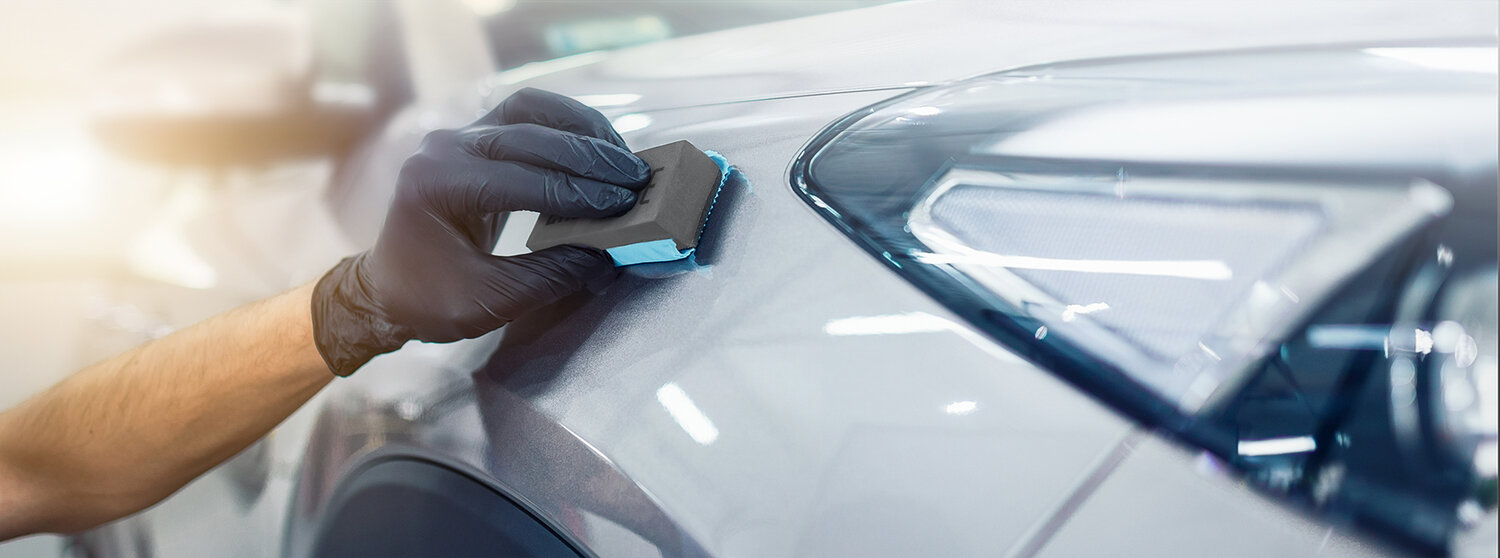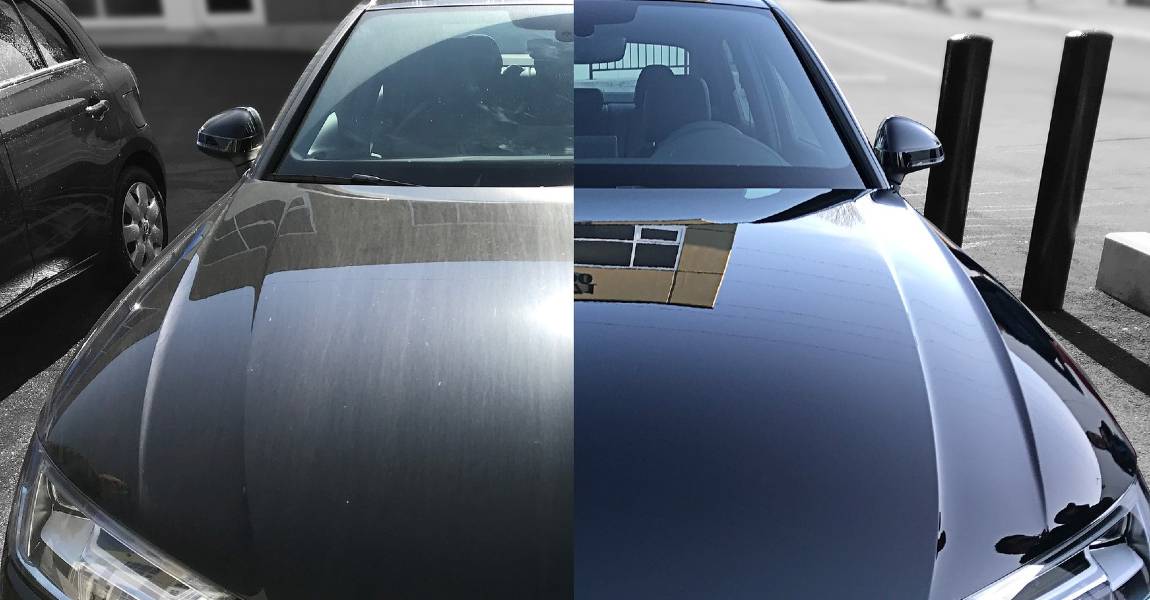Understanding the Scientific Research Behind Ceramic Coating for Improved Automobile Resilience
The science of ceramic finish is changing vehicle maintenance by providing an awesome guard against severe ecological aspects. At its core, this modern technology utilizes the power of silicon dioxide and titanium dioxide to develop a resilient, safety layer. What specifically makes these compounds so effective in safeguarding a vehicle's outside? As we check out the intricate make-up and application process of ceramic finishes, we uncover the tricks behind their remarkable protection and longevity. Exactly how does this contrast to standard methods, and what implications does it have for automobile upkeep in the lengthy term? The answers may shock you.

Make-up of Ceramic Coatings
Ceramic finishings are mainly made up of silicon dioxide (SiO2), which is stemmed from natural materials like quartz and sand. This compound creates the foundation of the finish, giving its particular hardness and resistance to ecological aspects. Along with SiO2, ceramic coatings often include titanium dioxide (TiO2) for boosted UV defense and increased resistance to environmental contaminants. These nanocomposite products create a durable, chemical bond with the lorry's surface area, offering a long-lasting safety layer.
The solution of ceramic layers is a thorough procedure where the concentration of SiO2 can substantially influence the layer's efficiency. Higher SiO2 material typically leads to higher sturdiness and firmness, adding to the covering's capacity to withstand scratches and chemical etching. The equilibrium of parts is critical; also much SiO2 can make the coating breakable, while also little can jeopardize its safety residential properties.
Makers may also incorporate added compounds, such as polysilazane, to enhance adaptability and simplicity of application. These additives boost the layer's hydrophobic buildings, making certain water and pollutants bead off the surface area effortlessly. This engineered make-up underscores the efficiency of ceramic finishings in securing an automobile's outside versus a selection of adverse problems.
Application Refine Clarified
Applying a ceramic finishing to a vehicle entails numerous crucial actions, each essential to making sure ideal attachment and performance of the safety layer - ceramic coating. The procedure begins with a complete clean and decontamination of the automobile's surface area to remove dust, grime, and previous waxes or sealers. This action is important as any type of impurities left externally can prevent the finish's capacity to bond successfully
Complying with the initial cleaning, the following action includes polishing the lorry to eliminate any type of blemishes, such as swirl marks or scrapes. Sprucing up guarantees a smooth surface area, which is vital for the finish to adhere effectively and give an uniform finish. After brightening, a surface prep work spray is used to eliminate any type of remaining residues and make sure that the surface is completely clean.

Protective Advantages
Often hailed for its extraordinary safety qualities, a ceramic finish provides numerous benefits that substantially boost car toughness. At its core, ceramic covering forms a hard, semi-permanent obstacle over an automobile's exterior, which acts as a guard versus various environmental dangers.
In addition, ceramic coverings display hydrophobic buildings, indicating they drive away water and facilitate a self-cleaning effect. This characteristic lowers the adherence of dirt and mud, simplifying upkeep and cleansing procedures. The finishing's resistance to chemical etching additionally ensures that the car's surface continues to be unblemished in spite of direct exposure to extreme cleansing representatives and pollutants.
Along with these protective benefits, the ceramic covering enhances a vehicle's aesthetic appeal by creating a glossy surface that emphasizes color deepness and quality. This not only maintains the vehicle's visual allure yet additionally adds to its lasting value by preserving the integrity of its exterior gradually.
Comparing to Standard Techniques
Unlike traditional methods of vehicle defense, such as shaving or sealants, ceramic coatings use a more resilient and long-lasting option. Where waxes and sealers normally supply a temporary layer of protection, commonly needing reapplication every couple of months, ceramic layers create a semi-permanent bond with the automobile's paint. This bond creates a safety layer that is resistant to environmental contaminants, UV damages, and small abrasions.
Standard waxes are primarily made up why not check here of all-natural components like carnauba wax, providing a shiny coating yet doing not have the durable safety high qualities of ceramic finishings. Sealers, while synthetic and offering slightly much better sturdiness than waxes, still fall brief in comparison to the resilience and chemical resistance of ceramic finishes. try this out The innovative modern technology of ceramic coverings includes nanotechnology, which permits them to load in tiny blemishes in the paint surface, resulting in a smoother and a lot more hydrophobic finish.
In terms of application, ceramic finishings need an even more careful procedure, usually demanding expert setup to ensure ideal performance. This contrasts with the relatively uncomplicated application of waxes and sealants, which can be applied at home. However, the remarkable defense and visual improvement given by ceramic coatings warrant the financial investment for those seeking lasting automobile preservation.
Longevity and Maintenance
Just how does the durability of ceramic coverings equate right into simplicity of upkeep for automobile proprietors? The innovative formula of ceramic coverings supplies a durable safety layer on the lorry's surface, which substantially expands the lifespan of the auto's outside coating. This sturdiness suggests that the finishing works as a shield against environmental contaminants such as UV rays, bird droppings, and roadway crud, which can otherwise weaken paintwork in time. Therefore, automobiles coated with ceramic products require much less frequent washing and outlining efforts, thus lowering upkeep time and expenses for proprietors.
Moreover, the hydrophobic nature of ceramic coatings allows water and other fluids to grain up and roll off the surface area, lugging dirt and debris with them. This residential or commercial property lessens the buildup of contaminants, making routine additional reading cleaning extra efficient and less labor-intensive. Proprietors gain from a consistently sleek, glossy appearance with marginal effort. While the covering itself is lasting, it is not totally maintenance-free. Normal examinations for damages and occasional reapplication are suggested to guarantee the protective layer continues to be intact. Therefore, ceramic finishes provide a beneficial balance between lasting durability and simplified upkeep for lorry treatment.
Conclusion
Ceramic finishes, with their sophisticated chemical structure of silicon dioxide and titanium dioxide, give a formidable obstacle against environmental damage, substantially boosting automobile resilience. When contrasted to typical techniques, ceramic layers supply superior defense against UV rays, oxidation, and chemical etching - ceramic coating.
The formulation of ceramic coverings is a thorough procedure where the focus of SiO2 can considerably influence the finish's efficiency.Applying a ceramic finish to a car involves several essential actions, each vital to making certain ideal adhesion and efficiency of the safety layer.Usually hailed for its extraordinary protective high qualities, a ceramic finishing provides various benefits that substantially enhance lorry resilience. The sophisticated formula of ceramic layers offers a robust protective layer on the lorry's surface area, which substantially extends the life-span of the automobile's outside coating.Ceramic finishes, with their sophisticated chemical composition of silicon dioxide and titanium dioxide, supply an awesome barrier against ecological damages, substantially enhancing car resilience.
Comments on “Why Ceramic Coating is a Game-Changer for Automotive Enthusiasts”